Environment, Trade, and Investment
VerifiedAdded on 2022/08/25
|14
|3670
|20
AI Summary
Contribute Materials
Your contribution can guide someone’s learning journey. Share your
documents today.
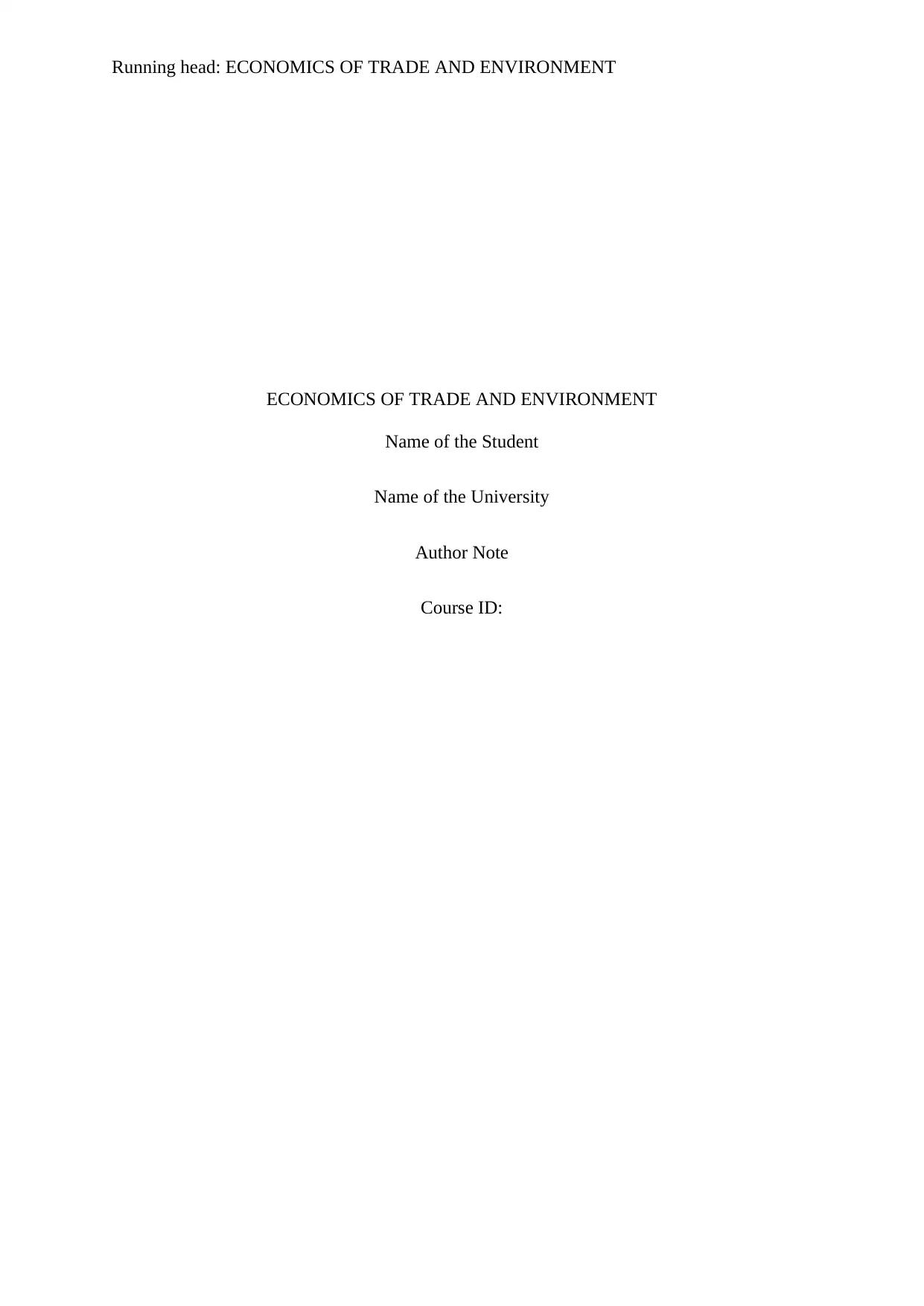
Running head: ECONOMICS OF TRADE AND ENVIRONMENT
ECONOMICS OF TRADE AND ENVIRONMENT
Name of the Student
Name of the University
Author Note
Course ID:
ECONOMICS OF TRADE AND ENVIRONMENT
Name of the Student
Name of the University
Author Note
Course ID:
Secure Best Marks with AI Grader
Need help grading? Try our AI Grader for instant feedback on your assignments.
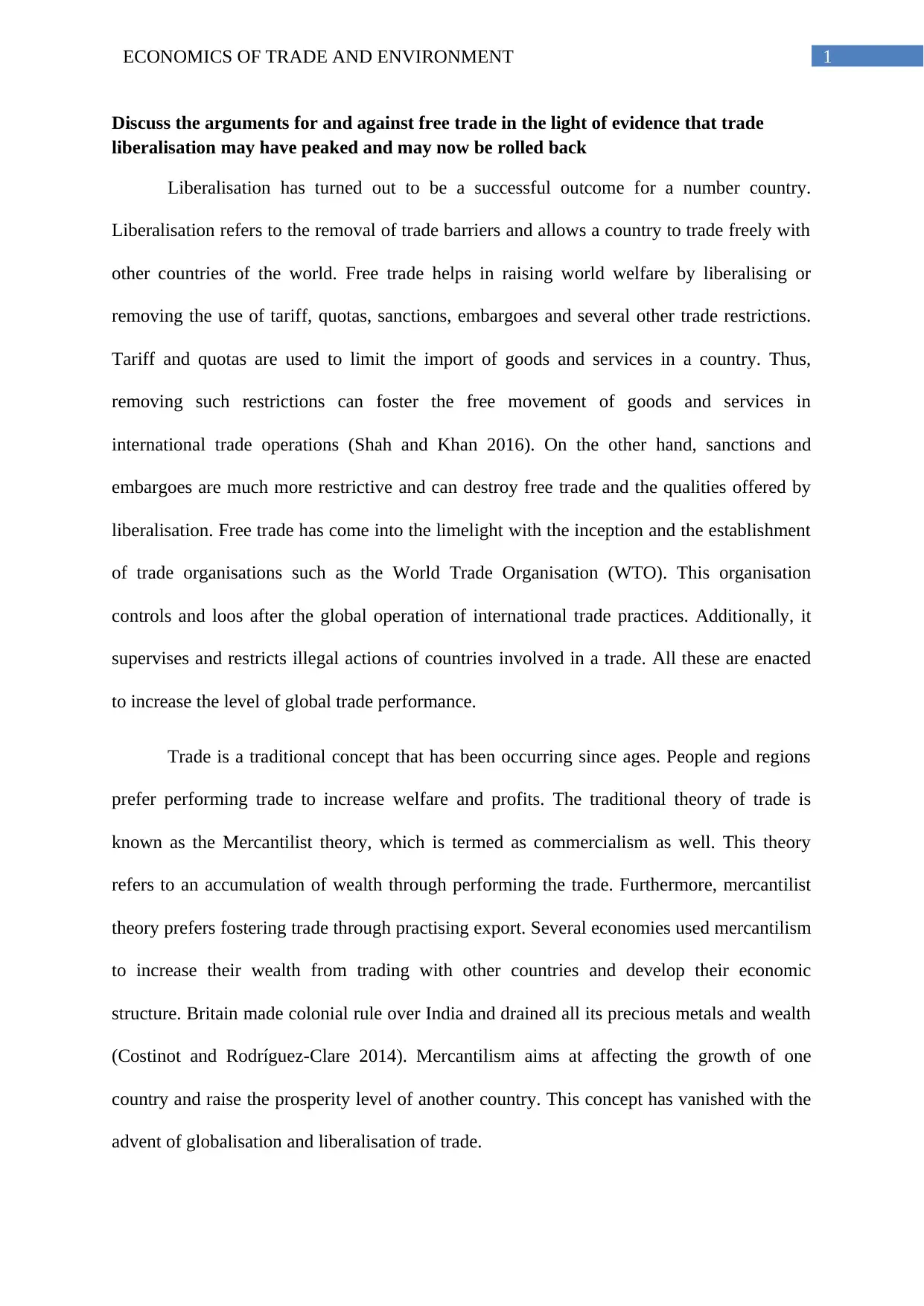
1ECONOMICS OF TRADE AND ENVIRONMENT
Discuss the arguments for and against free trade in the light of evidence that trade
liberalisation may have peaked and may now be rolled back
Liberalisation has turned out to be a successful outcome for a number country.
Liberalisation refers to the removal of trade barriers and allows a country to trade freely with
other countries of the world. Free trade helps in raising world welfare by liberalising or
removing the use of tariff, quotas, sanctions, embargoes and several other trade restrictions.
Tariff and quotas are used to limit the import of goods and services in a country. Thus,
removing such restrictions can foster the free movement of goods and services in
international trade operations (Shah and Khan 2016). On the other hand, sanctions and
embargoes are much more restrictive and can destroy free trade and the qualities offered by
liberalisation. Free trade has come into the limelight with the inception and the establishment
of trade organisations such as the World Trade Organisation (WTO). This organisation
controls and loos after the global operation of international trade practices. Additionally, it
supervises and restricts illegal actions of countries involved in a trade. All these are enacted
to increase the level of global trade performance.
Trade is a traditional concept that has been occurring since ages. People and regions
prefer performing trade to increase welfare and profits. The traditional theory of trade is
known as the Mercantilist theory, which is termed as commercialism as well. This theory
refers to an accumulation of wealth through performing the trade. Furthermore, mercantilist
theory prefers fostering trade through practising export. Several economies used mercantilism
to increase their wealth from trading with other countries and develop their economic
structure. Britain made colonial rule over India and drained all its precious metals and wealth
(Costinot and Rodríguez-Clare 2014). Mercantilism aims at affecting the growth of one
country and raise the prosperity level of another country. This concept has vanished with the
advent of globalisation and liberalisation of trade.
Discuss the arguments for and against free trade in the light of evidence that trade
liberalisation may have peaked and may now be rolled back
Liberalisation has turned out to be a successful outcome for a number country.
Liberalisation refers to the removal of trade barriers and allows a country to trade freely with
other countries of the world. Free trade helps in raising world welfare by liberalising or
removing the use of tariff, quotas, sanctions, embargoes and several other trade restrictions.
Tariff and quotas are used to limit the import of goods and services in a country. Thus,
removing such restrictions can foster the free movement of goods and services in
international trade operations (Shah and Khan 2016). On the other hand, sanctions and
embargoes are much more restrictive and can destroy free trade and the qualities offered by
liberalisation. Free trade has come into the limelight with the inception and the establishment
of trade organisations such as the World Trade Organisation (WTO). This organisation
controls and loos after the global operation of international trade practices. Additionally, it
supervises and restricts illegal actions of countries involved in a trade. All these are enacted
to increase the level of global trade performance.
Trade is a traditional concept that has been occurring since ages. People and regions
prefer performing trade to increase welfare and profits. The traditional theory of trade is
known as the Mercantilist theory, which is termed as commercialism as well. This theory
refers to an accumulation of wealth through performing the trade. Furthermore, mercantilist
theory prefers fostering trade through practising export. Several economies used mercantilism
to increase their wealth from trading with other countries and develop their economic
structure. Britain made colonial rule over India and drained all its precious metals and wealth
(Costinot and Rodríguez-Clare 2014). Mercantilism aims at affecting the growth of one
country and raise the prosperity level of another country. This concept has vanished with the
advent of globalisation and liberalisation of trade.
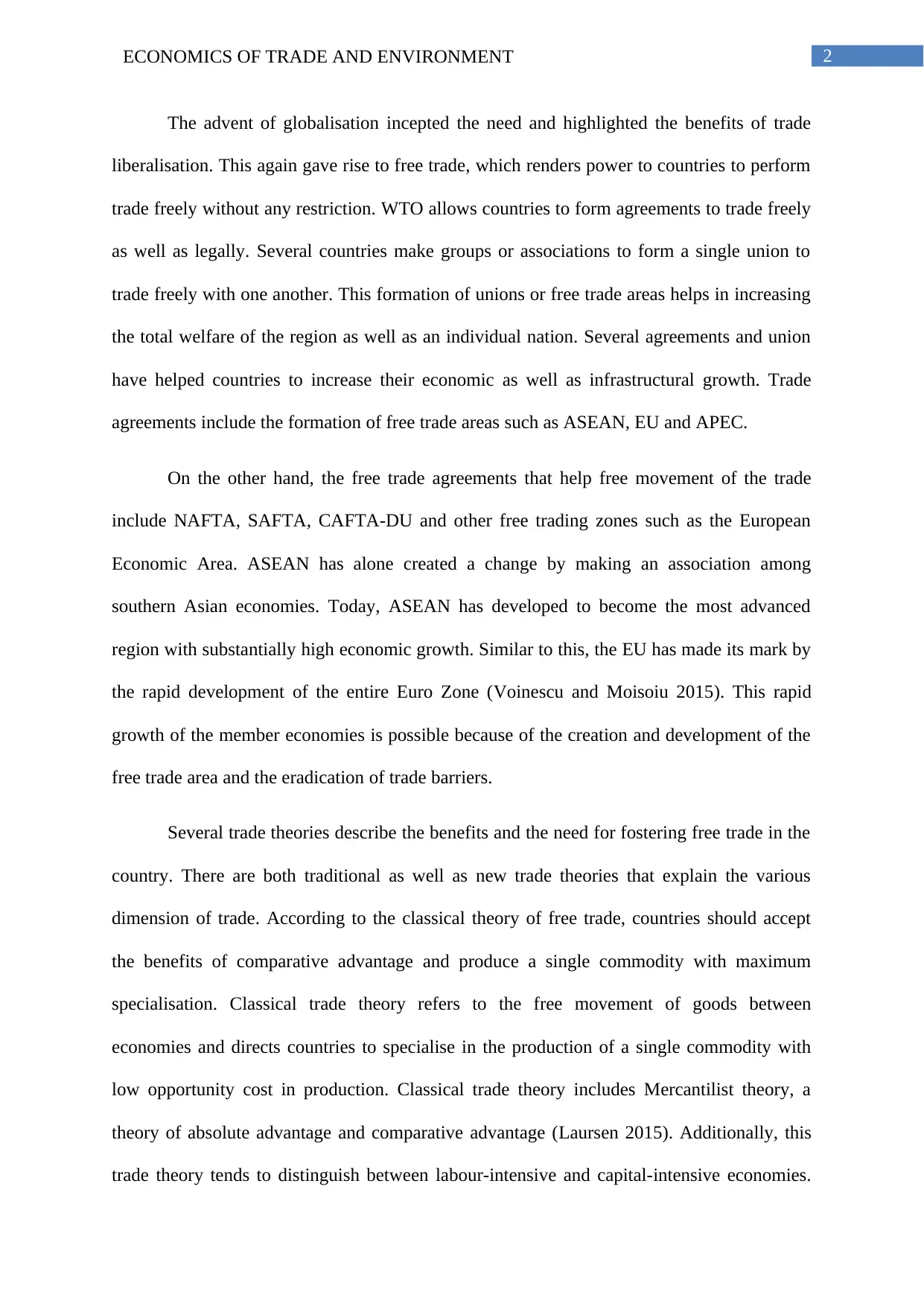
2ECONOMICS OF TRADE AND ENVIRONMENT
The advent of globalisation incepted the need and highlighted the benefits of trade
liberalisation. This again gave rise to free trade, which renders power to countries to perform
trade freely without any restriction. WTO allows countries to form agreements to trade freely
as well as legally. Several countries make groups or associations to form a single union to
trade freely with one another. This formation of unions or free trade areas helps in increasing
the total welfare of the region as well as an individual nation. Several agreements and union
have helped countries to increase their economic as well as infrastructural growth. Trade
agreements include the formation of free trade areas such as ASEAN, EU and APEC.
On the other hand, the free trade agreements that help free movement of the trade
include NAFTA, SAFTA, CAFTA-DU and other free trading zones such as the European
Economic Area. ASEAN has alone created a change by making an association among
southern Asian economies. Today, ASEAN has developed to become the most advanced
region with substantially high economic growth. Similar to this, the EU has made its mark by
the rapid development of the entire Euro Zone (Voinescu and Moisoiu 2015). This rapid
growth of the member economies is possible because of the creation and development of the
free trade area and the eradication of trade barriers.
Several trade theories describe the benefits and the need for fostering free trade in the
country. There are both traditional as well as new trade theories that explain the various
dimension of trade. According to the classical theory of free trade, countries should accept
the benefits of comparative advantage and produce a single commodity with maximum
specialisation. Classical trade theory refers to the free movement of goods between
economies and directs countries to specialise in the production of a single commodity with
low opportunity cost in production. Classical trade theory includes Mercantilist theory, a
theory of absolute advantage and comparative advantage (Laursen 2015). Additionally, this
trade theory tends to distinguish between labour-intensive and capital-intensive economies.
The advent of globalisation incepted the need and highlighted the benefits of trade
liberalisation. This again gave rise to free trade, which renders power to countries to perform
trade freely without any restriction. WTO allows countries to form agreements to trade freely
as well as legally. Several countries make groups or associations to form a single union to
trade freely with one another. This formation of unions or free trade areas helps in increasing
the total welfare of the region as well as an individual nation. Several agreements and union
have helped countries to increase their economic as well as infrastructural growth. Trade
agreements include the formation of free trade areas such as ASEAN, EU and APEC.
On the other hand, the free trade agreements that help free movement of the trade
include NAFTA, SAFTA, CAFTA-DU and other free trading zones such as the European
Economic Area. ASEAN has alone created a change by making an association among
southern Asian economies. Today, ASEAN has developed to become the most advanced
region with substantially high economic growth. Similar to this, the EU has made its mark by
the rapid development of the entire Euro Zone (Voinescu and Moisoiu 2015). This rapid
growth of the member economies is possible because of the creation and development of the
free trade area and the eradication of trade barriers.
Several trade theories describe the benefits and the need for fostering free trade in the
country. There are both traditional as well as new trade theories that explain the various
dimension of trade. According to the classical theory of free trade, countries should accept
the benefits of comparative advantage and produce a single commodity with maximum
specialisation. Classical trade theory refers to the free movement of goods between
economies and directs countries to specialise in the production of a single commodity with
low opportunity cost in production. Classical trade theory includes Mercantilist theory, a
theory of absolute advantage and comparative advantage (Laursen 2015). Additionally, this
trade theory tends to distinguish between labour-intensive and capital-intensive economies.
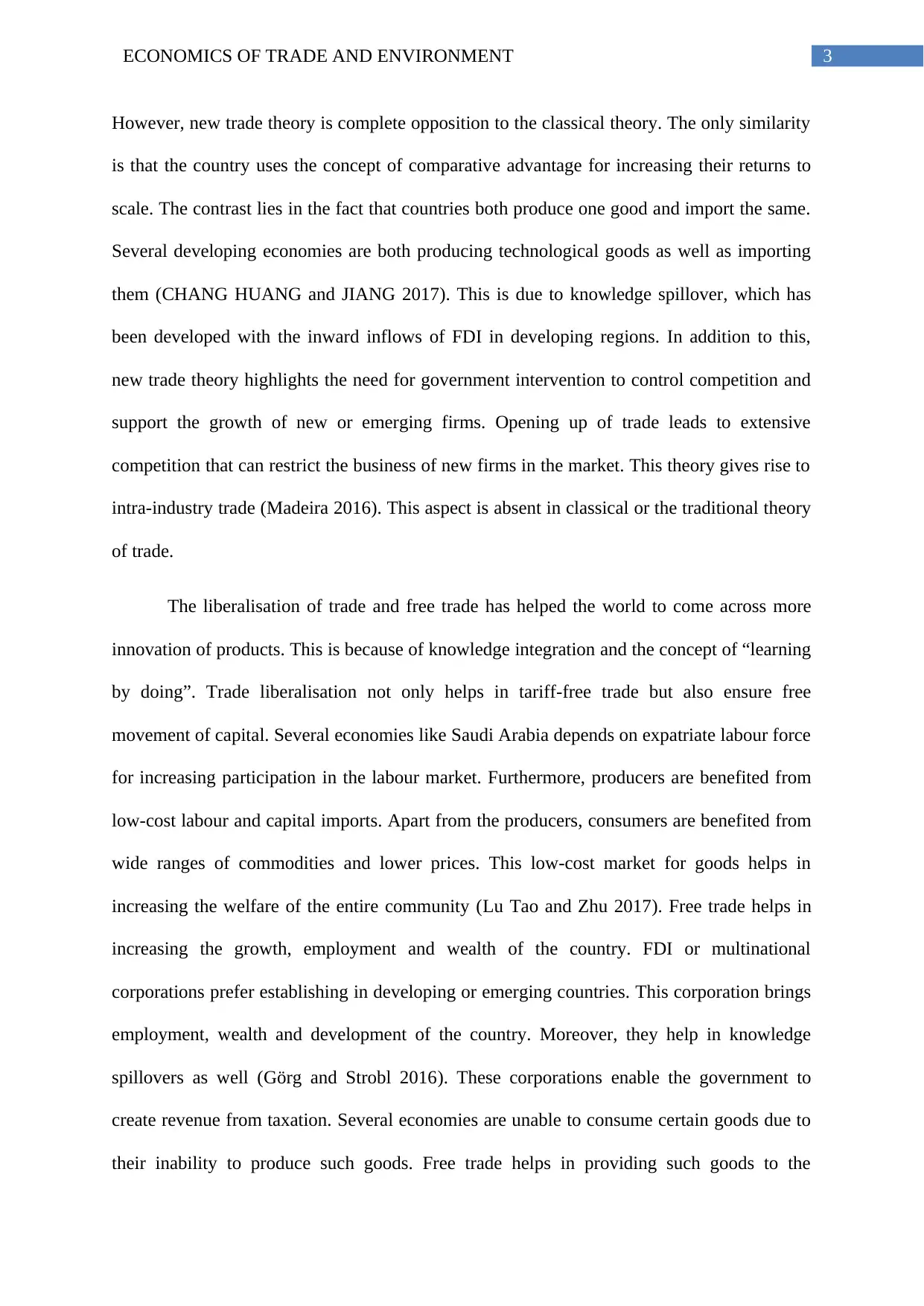
3ECONOMICS OF TRADE AND ENVIRONMENT
However, new trade theory is complete opposition to the classical theory. The only similarity
is that the country uses the concept of comparative advantage for increasing their returns to
scale. The contrast lies in the fact that countries both produce one good and import the same.
Several developing economies are both producing technological goods as well as importing
them (CHANG HUANG and JIANG 2017). This is due to knowledge spillover, which has
been developed with the inward inflows of FDI in developing regions. In addition to this,
new trade theory highlights the need for government intervention to control competition and
support the growth of new or emerging firms. Opening up of trade leads to extensive
competition that can restrict the business of new firms in the market. This theory gives rise to
intra-industry trade (Madeira 2016). This aspect is absent in classical or the traditional theory
of trade.
The liberalisation of trade and free trade has helped the world to come across more
innovation of products. This is because of knowledge integration and the concept of “learning
by doing”. Trade liberalisation not only helps in tariff-free trade but also ensure free
movement of capital. Several economies like Saudi Arabia depends on expatriate labour force
for increasing participation in the labour market. Furthermore, producers are benefited from
low-cost labour and capital imports. Apart from the producers, consumers are benefited from
wide ranges of commodities and lower prices. This low-cost market for goods helps in
increasing the welfare of the entire community (Lu Tao and Zhu 2017). Free trade helps in
increasing the growth, employment and wealth of the country. FDI or multinational
corporations prefer establishing in developing or emerging countries. This corporation brings
employment, wealth and development of the country. Moreover, they help in knowledge
spillovers as well (Görg and Strobl 2016). These corporations enable the government to
create revenue from taxation. Several economies are unable to consume certain goods due to
their inability to produce such goods. Free trade helps in providing such goods to the
However, new trade theory is complete opposition to the classical theory. The only similarity
is that the country uses the concept of comparative advantage for increasing their returns to
scale. The contrast lies in the fact that countries both produce one good and import the same.
Several developing economies are both producing technological goods as well as importing
them (CHANG HUANG and JIANG 2017). This is due to knowledge spillover, which has
been developed with the inward inflows of FDI in developing regions. In addition to this,
new trade theory highlights the need for government intervention to control competition and
support the growth of new or emerging firms. Opening up of trade leads to extensive
competition that can restrict the business of new firms in the market. This theory gives rise to
intra-industry trade (Madeira 2016). This aspect is absent in classical or the traditional theory
of trade.
The liberalisation of trade and free trade has helped the world to come across more
innovation of products. This is because of knowledge integration and the concept of “learning
by doing”. Trade liberalisation not only helps in tariff-free trade but also ensure free
movement of capital. Several economies like Saudi Arabia depends on expatriate labour force
for increasing participation in the labour market. Furthermore, producers are benefited from
low-cost labour and capital imports. Apart from the producers, consumers are benefited from
wide ranges of commodities and lower prices. This low-cost market for goods helps in
increasing the welfare of the entire community (Lu Tao and Zhu 2017). Free trade helps in
increasing the growth, employment and wealth of the country. FDI or multinational
corporations prefer establishing in developing or emerging countries. This corporation brings
employment, wealth and development of the country. Moreover, they help in knowledge
spillovers as well (Görg and Strobl 2016). These corporations enable the government to
create revenue from taxation. Several economies are unable to consume certain goods due to
their inability to produce such goods. Free trade helps in providing such goods to the
Secure Best Marks with AI Grader
Need help grading? Try our AI Grader for instant feedback on your assignments.
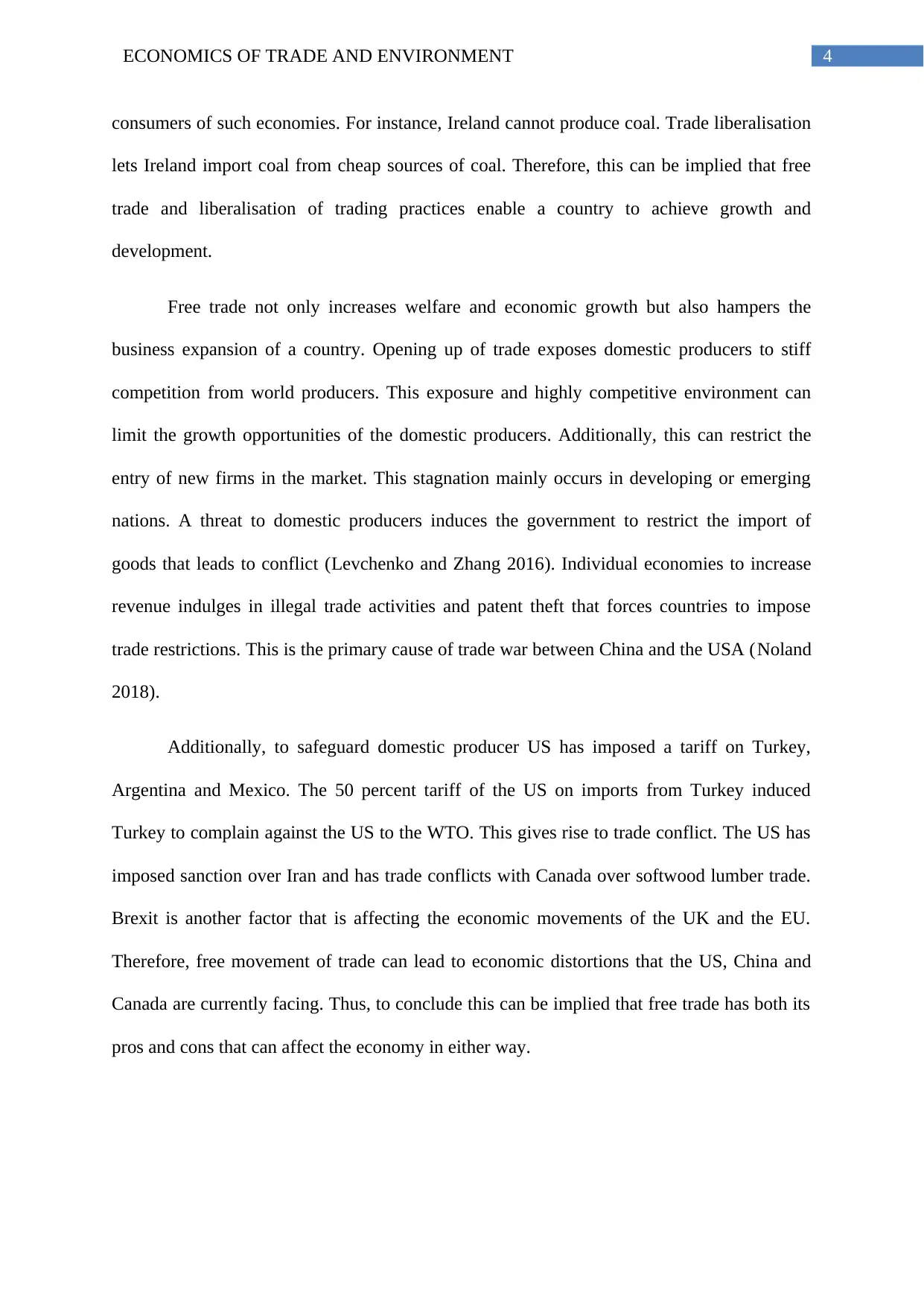
4ECONOMICS OF TRADE AND ENVIRONMENT
consumers of such economies. For instance, Ireland cannot produce coal. Trade liberalisation
lets Ireland import coal from cheap sources of coal. Therefore, this can be implied that free
trade and liberalisation of trading practices enable a country to achieve growth and
development.
Free trade not only increases welfare and economic growth but also hampers the
business expansion of a country. Opening up of trade exposes domestic producers to stiff
competition from world producers. This exposure and highly competitive environment can
limit the growth opportunities of the domestic producers. Additionally, this can restrict the
entry of new firms in the market. This stagnation mainly occurs in developing or emerging
nations. A threat to domestic producers induces the government to restrict the import of
goods that leads to conflict (Levchenko and Zhang 2016). Individual economies to increase
revenue indulges in illegal trade activities and patent theft that forces countries to impose
trade restrictions. This is the primary cause of trade war between China and the USA (Noland
2018).
Additionally, to safeguard domestic producer US has imposed a tariff on Turkey,
Argentina and Mexico. The 50 percent tariff of the US on imports from Turkey induced
Turkey to complain against the US to the WTO. This gives rise to trade conflict. The US has
imposed sanction over Iran and has trade conflicts with Canada over softwood lumber trade.
Brexit is another factor that is affecting the economic movements of the UK and the EU.
Therefore, free movement of trade can lead to economic distortions that the US, China and
Canada are currently facing. Thus, to conclude this can be implied that free trade has both its
pros and cons that can affect the economy in either way.
consumers of such economies. For instance, Ireland cannot produce coal. Trade liberalisation
lets Ireland import coal from cheap sources of coal. Therefore, this can be implied that free
trade and liberalisation of trading practices enable a country to achieve growth and
development.
Free trade not only increases welfare and economic growth but also hampers the
business expansion of a country. Opening up of trade exposes domestic producers to stiff
competition from world producers. This exposure and highly competitive environment can
limit the growth opportunities of the domestic producers. Additionally, this can restrict the
entry of new firms in the market. This stagnation mainly occurs in developing or emerging
nations. A threat to domestic producers induces the government to restrict the import of
goods that leads to conflict (Levchenko and Zhang 2016). Individual economies to increase
revenue indulges in illegal trade activities and patent theft that forces countries to impose
trade restrictions. This is the primary cause of trade war between China and the USA (Noland
2018).
Additionally, to safeguard domestic producer US has imposed a tariff on Turkey,
Argentina and Mexico. The 50 percent tariff of the US on imports from Turkey induced
Turkey to complain against the US to the WTO. This gives rise to trade conflict. The US has
imposed sanction over Iran and has trade conflicts with Canada over softwood lumber trade.
Brexit is another factor that is affecting the economic movements of the UK and the EU.
Therefore, free movement of trade can lead to economic distortions that the US, China and
Canada are currently facing. Thus, to conclude this can be implied that free trade has both its
pros and cons that can affect the economy in either way.
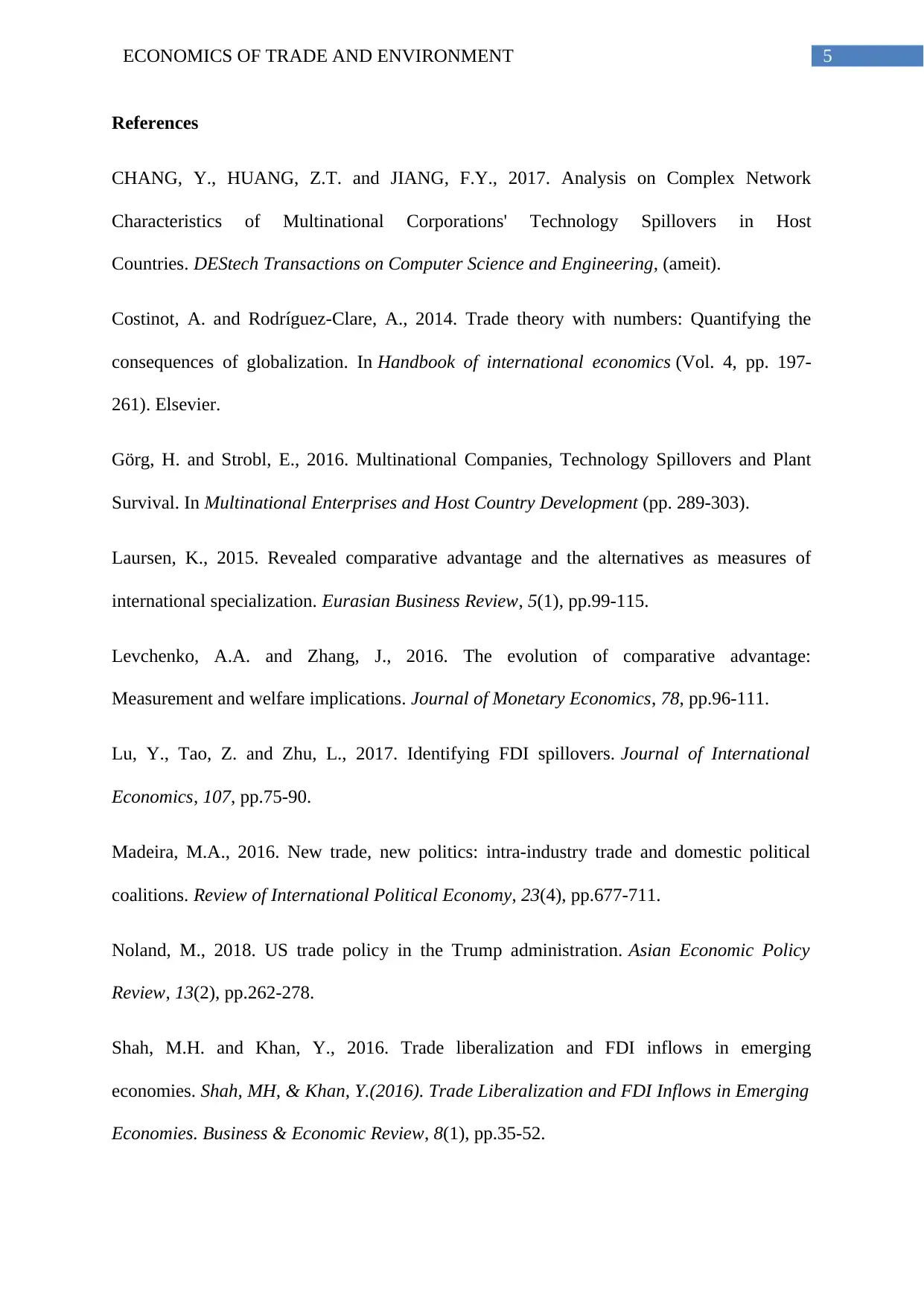
5ECONOMICS OF TRADE AND ENVIRONMENT
References
CHANG, Y., HUANG, Z.T. and JIANG, F.Y., 2017. Analysis on Complex Network
Characteristics of Multinational Corporations' Technology Spillovers in Host
Countries. DEStech Transactions on Computer Science and Engineering, (ameit).
Costinot, A. and Rodríguez-Clare, A., 2014. Trade theory with numbers: Quantifying the
consequences of globalization. In Handbook of international economics (Vol. 4, pp. 197-
261). Elsevier.
Görg, H. and Strobl, E., 2016. Multinational Companies, Technology Spillovers and Plant
Survival. In Multinational Enterprises and Host Country Development (pp. 289-303).
Laursen, K., 2015. Revealed comparative advantage and the alternatives as measures of
international specialization. Eurasian Business Review, 5(1), pp.99-115.
Levchenko, A.A. and Zhang, J., 2016. The evolution of comparative advantage:
Measurement and welfare implications. Journal of Monetary Economics, 78, pp.96-111.
Lu, Y., Tao, Z. and Zhu, L., 2017. Identifying FDI spillovers. Journal of International
Economics, 107, pp.75-90.
Madeira, M.A., 2016. New trade, new politics: intra-industry trade and domestic political
coalitions. Review of International Political Economy, 23(4), pp.677-711.
Noland, M., 2018. US trade policy in the Trump administration. Asian Economic Policy
Review, 13(2), pp.262-278.
Shah, M.H. and Khan, Y., 2016. Trade liberalization and FDI inflows in emerging
economies. Shah, MH, & Khan, Y.(2016). Trade Liberalization and FDI Inflows in Emerging
Economies. Business & Economic Review, 8(1), pp.35-52.
References
CHANG, Y., HUANG, Z.T. and JIANG, F.Y., 2017. Analysis on Complex Network
Characteristics of Multinational Corporations' Technology Spillovers in Host
Countries. DEStech Transactions on Computer Science and Engineering, (ameit).
Costinot, A. and Rodríguez-Clare, A., 2014. Trade theory with numbers: Quantifying the
consequences of globalization. In Handbook of international economics (Vol. 4, pp. 197-
261). Elsevier.
Görg, H. and Strobl, E., 2016. Multinational Companies, Technology Spillovers and Plant
Survival. In Multinational Enterprises and Host Country Development (pp. 289-303).
Laursen, K., 2015. Revealed comparative advantage and the alternatives as measures of
international specialization. Eurasian Business Review, 5(1), pp.99-115.
Levchenko, A.A. and Zhang, J., 2016. The evolution of comparative advantage:
Measurement and welfare implications. Journal of Monetary Economics, 78, pp.96-111.
Lu, Y., Tao, Z. and Zhu, L., 2017. Identifying FDI spillovers. Journal of International
Economics, 107, pp.75-90.
Madeira, M.A., 2016. New trade, new politics: intra-industry trade and domestic political
coalitions. Review of International Political Economy, 23(4), pp.677-711.
Noland, M., 2018. US trade policy in the Trump administration. Asian Economic Policy
Review, 13(2), pp.262-278.
Shah, M.H. and Khan, Y., 2016. Trade liberalization and FDI inflows in emerging
economies. Shah, MH, & Khan, Y.(2016). Trade Liberalization and FDI Inflows in Emerging
Economies. Business & Economic Review, 8(1), pp.35-52.
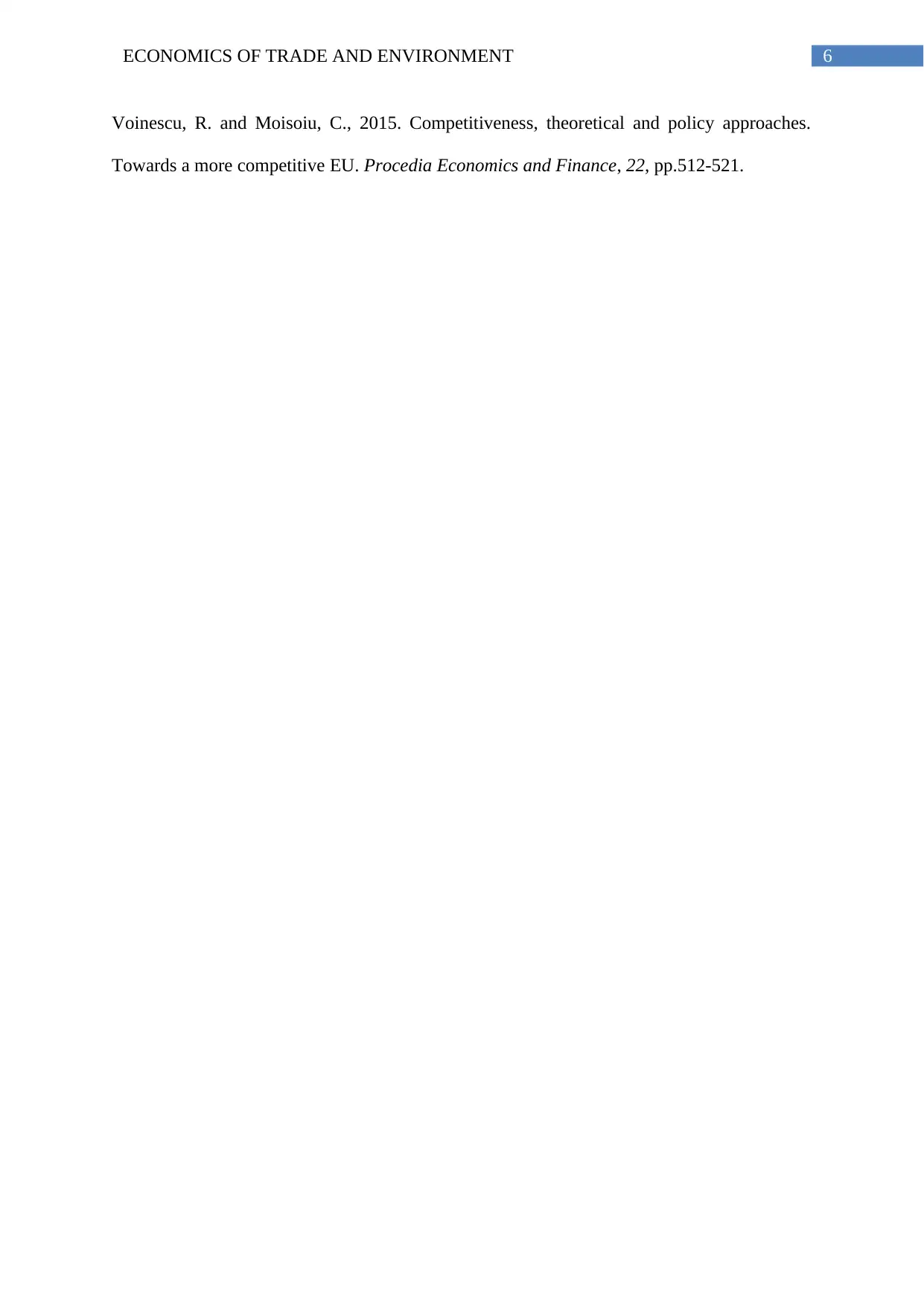
6ECONOMICS OF TRADE AND ENVIRONMENT
Voinescu, R. and Moisoiu, C., 2015. Competitiveness, theoretical and policy approaches.
Towards a more competitive EU. Procedia Economics and Finance, 22, pp.512-521.
Voinescu, R. and Moisoiu, C., 2015. Competitiveness, theoretical and policy approaches.
Towards a more competitive EU. Procedia Economics and Finance, 22, pp.512-521.
Paraphrase This Document
Need a fresh take? Get an instant paraphrase of this document with our AI Paraphraser
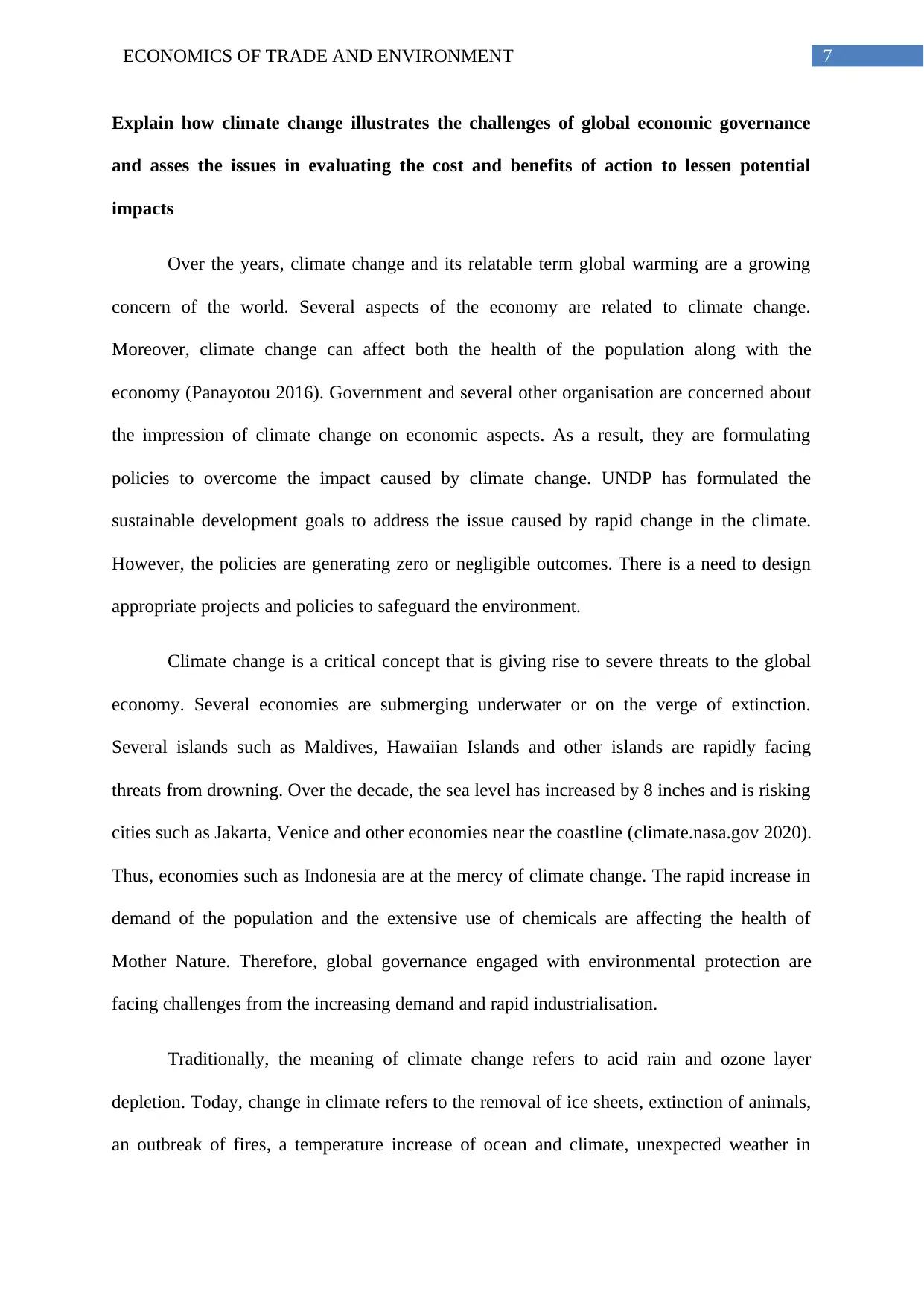
7ECONOMICS OF TRADE AND ENVIRONMENT
Explain how climate change illustrates the challenges of global economic governance
and asses the issues in evaluating the cost and benefits of action to lessen potential
impacts
Over the years, climate change and its relatable term global warming are a growing
concern of the world. Several aspects of the economy are related to climate change.
Moreover, climate change can affect both the health of the population along with the
economy (Panayotou 2016). Government and several other organisation are concerned about
the impression of climate change on economic aspects. As a result, they are formulating
policies to overcome the impact caused by climate change. UNDP has formulated the
sustainable development goals to address the issue caused by rapid change in the climate.
However, the policies are generating zero or negligible outcomes. There is a need to design
appropriate projects and policies to safeguard the environment.
Climate change is a critical concept that is giving rise to severe threats to the global
economy. Several economies are submerging underwater or on the verge of extinction.
Several islands such as Maldives, Hawaiian Islands and other islands are rapidly facing
threats from drowning. Over the decade, the sea level has increased by 8 inches and is risking
cities such as Jakarta, Venice and other economies near the coastline (climate.nasa.gov 2020).
Thus, economies such as Indonesia are at the mercy of climate change. The rapid increase in
demand of the population and the extensive use of chemicals are affecting the health of
Mother Nature. Therefore, global governance engaged with environmental protection are
facing challenges from the increasing demand and rapid industrialisation.
Traditionally, the meaning of climate change refers to acid rain and ozone layer
depletion. Today, change in climate refers to the removal of ice sheets, extinction of animals,
an outbreak of fires, a temperature increase of ocean and climate, unexpected weather in
Explain how climate change illustrates the challenges of global economic governance
and asses the issues in evaluating the cost and benefits of action to lessen potential
impacts
Over the years, climate change and its relatable term global warming are a growing
concern of the world. Several aspects of the economy are related to climate change.
Moreover, climate change can affect both the health of the population along with the
economy (Panayotou 2016). Government and several other organisation are concerned about
the impression of climate change on economic aspects. As a result, they are formulating
policies to overcome the impact caused by climate change. UNDP has formulated the
sustainable development goals to address the issue caused by rapid change in the climate.
However, the policies are generating zero or negligible outcomes. There is a need to design
appropriate projects and policies to safeguard the environment.
Climate change is a critical concept that is giving rise to severe threats to the global
economy. Several economies are submerging underwater or on the verge of extinction.
Several islands such as Maldives, Hawaiian Islands and other islands are rapidly facing
threats from drowning. Over the decade, the sea level has increased by 8 inches and is risking
cities such as Jakarta, Venice and other economies near the coastline (climate.nasa.gov 2020).
Thus, economies such as Indonesia are at the mercy of climate change. The rapid increase in
demand of the population and the extensive use of chemicals are affecting the health of
Mother Nature. Therefore, global governance engaged with environmental protection are
facing challenges from the increasing demand and rapid industrialisation.
Traditionally, the meaning of climate change refers to acid rain and ozone layer
depletion. Today, change in climate refers to the removal of ice sheets, extinction of animals,
an outbreak of fires, a temperature increase of ocean and climate, unexpected weather in
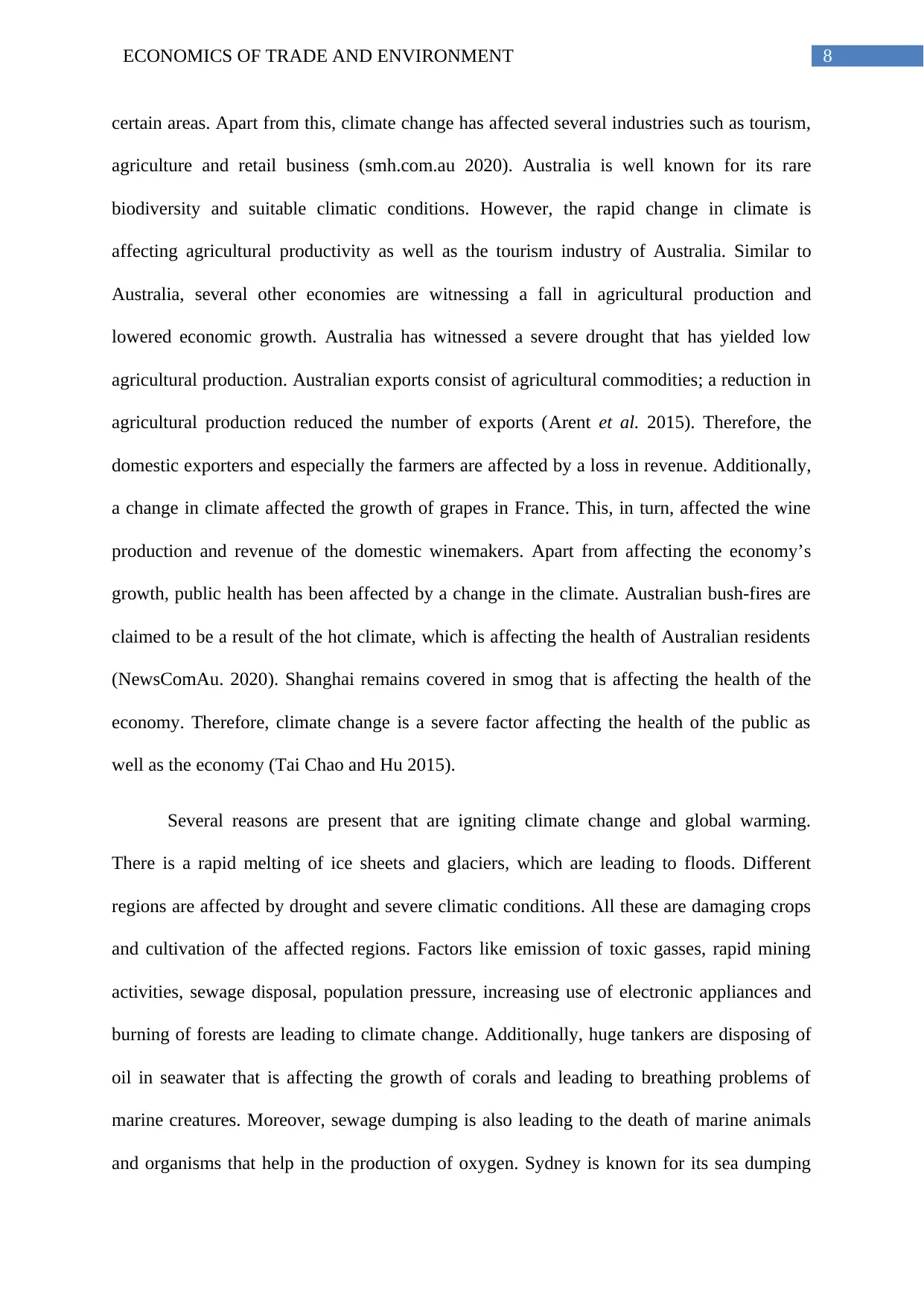
8ECONOMICS OF TRADE AND ENVIRONMENT
certain areas. Apart from this, climate change has affected several industries such as tourism,
agriculture and retail business (smh.com.au 2020). Australia is well known for its rare
biodiversity and suitable climatic conditions. However, the rapid change in climate is
affecting agricultural productivity as well as the tourism industry of Australia. Similar to
Australia, several other economies are witnessing a fall in agricultural production and
lowered economic growth. Australia has witnessed a severe drought that has yielded low
agricultural production. Australian exports consist of agricultural commodities; a reduction in
agricultural production reduced the number of exports (Arent et al. 2015). Therefore, the
domestic exporters and especially the farmers are affected by a loss in revenue. Additionally,
a change in climate affected the growth of grapes in France. This, in turn, affected the wine
production and revenue of the domestic winemakers. Apart from affecting the economy’s
growth, public health has been affected by a change in the climate. Australian bush-fires are
claimed to be a result of the hot climate, which is affecting the health of Australian residents
(NewsComAu. 2020). Shanghai remains covered in smog that is affecting the health of the
economy. Therefore, climate change is a severe factor affecting the health of the public as
well as the economy (Tai Chao and Hu 2015).
Several reasons are present that are igniting climate change and global warming.
There is a rapid melting of ice sheets and glaciers, which are leading to floods. Different
regions are affected by drought and severe climatic conditions. All these are damaging crops
and cultivation of the affected regions. Factors like emission of toxic gasses, rapid mining
activities, sewage disposal, population pressure, increasing use of electronic appliances and
burning of forests are leading to climate change. Additionally, huge tankers are disposing of
oil in seawater that is affecting the growth of corals and leading to breathing problems of
marine creatures. Moreover, sewage dumping is also leading to the death of marine animals
and organisms that help in the production of oxygen. Sydney is known for its sea dumping
certain areas. Apart from this, climate change has affected several industries such as tourism,
agriculture and retail business (smh.com.au 2020). Australia is well known for its rare
biodiversity and suitable climatic conditions. However, the rapid change in climate is
affecting agricultural productivity as well as the tourism industry of Australia. Similar to
Australia, several other economies are witnessing a fall in agricultural production and
lowered economic growth. Australia has witnessed a severe drought that has yielded low
agricultural production. Australian exports consist of agricultural commodities; a reduction in
agricultural production reduced the number of exports (Arent et al. 2015). Therefore, the
domestic exporters and especially the farmers are affected by a loss in revenue. Additionally,
a change in climate affected the growth of grapes in France. This, in turn, affected the wine
production and revenue of the domestic winemakers. Apart from affecting the economy’s
growth, public health has been affected by a change in the climate. Australian bush-fires are
claimed to be a result of the hot climate, which is affecting the health of Australian residents
(NewsComAu. 2020). Shanghai remains covered in smog that is affecting the health of the
economy. Therefore, climate change is a severe factor affecting the health of the public as
well as the economy (Tai Chao and Hu 2015).
Several reasons are present that are igniting climate change and global warming.
There is a rapid melting of ice sheets and glaciers, which are leading to floods. Different
regions are affected by drought and severe climatic conditions. All these are damaging crops
and cultivation of the affected regions. Factors like emission of toxic gasses, rapid mining
activities, sewage disposal, population pressure, increasing use of electronic appliances and
burning of forests are leading to climate change. Additionally, huge tankers are disposing of
oil in seawater that is affecting the growth of corals and leading to breathing problems of
marine creatures. Moreover, sewage dumping is also leading to the death of marine animals
and organisms that help in the production of oxygen. Sydney is known for its sea dumping
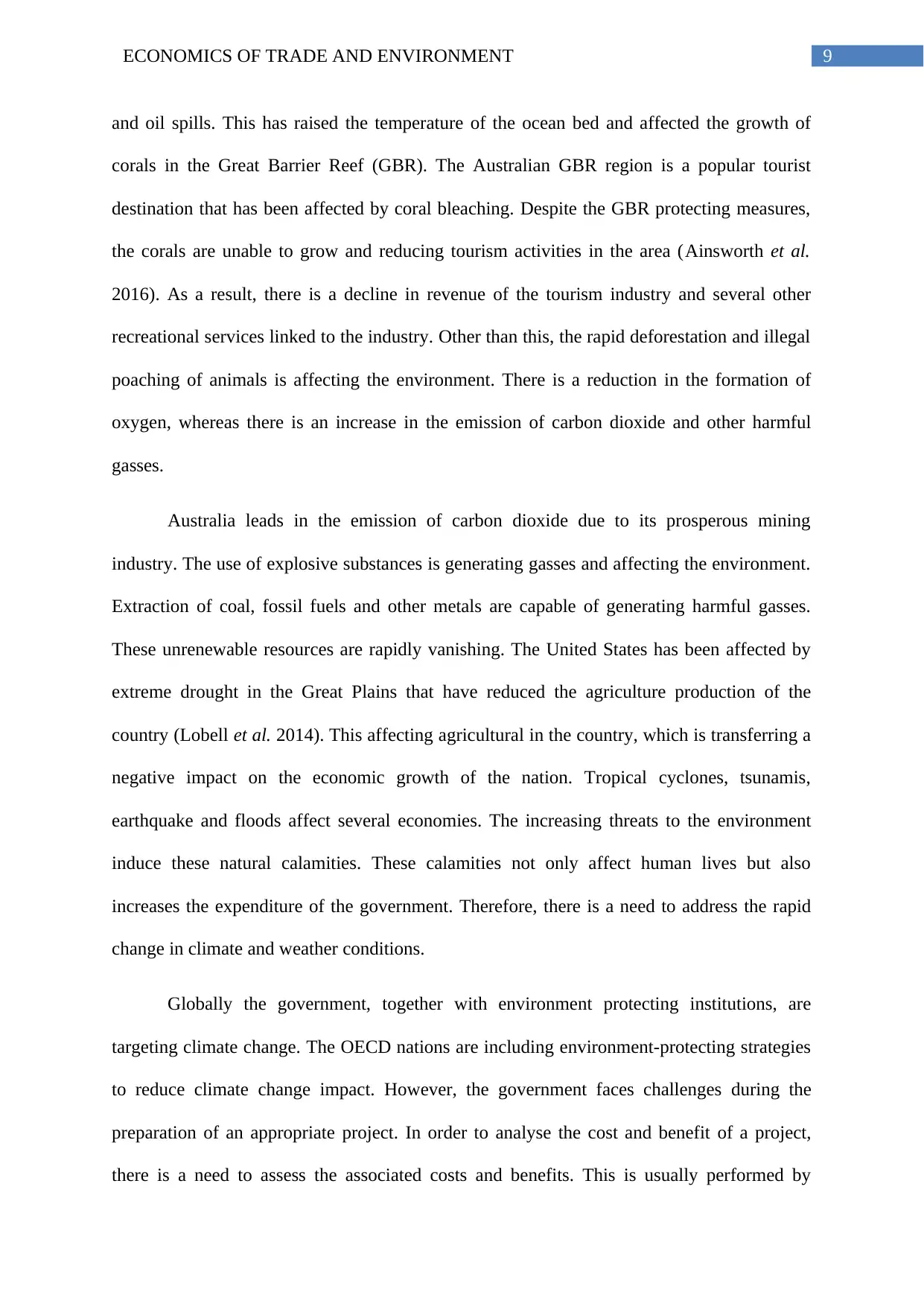
9ECONOMICS OF TRADE AND ENVIRONMENT
and oil spills. This has raised the temperature of the ocean bed and affected the growth of
corals in the Great Barrier Reef (GBR). The Australian GBR region is a popular tourist
destination that has been affected by coral bleaching. Despite the GBR protecting measures,
the corals are unable to grow and reducing tourism activities in the area (Ainsworth et al.
2016). As a result, there is a decline in revenue of the tourism industry and several other
recreational services linked to the industry. Other than this, the rapid deforestation and illegal
poaching of animals is affecting the environment. There is a reduction in the formation of
oxygen, whereas there is an increase in the emission of carbon dioxide and other harmful
gasses.
Australia leads in the emission of carbon dioxide due to its prosperous mining
industry. The use of explosive substances is generating gasses and affecting the environment.
Extraction of coal, fossil fuels and other metals are capable of generating harmful gasses.
These unrenewable resources are rapidly vanishing. The United States has been affected by
extreme drought in the Great Plains that have reduced the agriculture production of the
country (Lobell et al. 2014). This affecting agricultural in the country, which is transferring a
negative impact on the economic growth of the nation. Tropical cyclones, tsunamis,
earthquake and floods affect several economies. The increasing threats to the environment
induce these natural calamities. These calamities not only affect human lives but also
increases the expenditure of the government. Therefore, there is a need to address the rapid
change in climate and weather conditions.
Globally the government, together with environment protecting institutions, are
targeting climate change. The OECD nations are including environment-protecting strategies
to reduce climate change impact. However, the government faces challenges during the
preparation of an appropriate project. In order to analyse the cost and benefit of a project,
there is a need to assess the associated costs and benefits. This is usually performed by
and oil spills. This has raised the temperature of the ocean bed and affected the growth of
corals in the Great Barrier Reef (GBR). The Australian GBR region is a popular tourist
destination that has been affected by coral bleaching. Despite the GBR protecting measures,
the corals are unable to grow and reducing tourism activities in the area (Ainsworth et al.
2016). As a result, there is a decline in revenue of the tourism industry and several other
recreational services linked to the industry. Other than this, the rapid deforestation and illegal
poaching of animals is affecting the environment. There is a reduction in the formation of
oxygen, whereas there is an increase in the emission of carbon dioxide and other harmful
gasses.
Australia leads in the emission of carbon dioxide due to its prosperous mining
industry. The use of explosive substances is generating gasses and affecting the environment.
Extraction of coal, fossil fuels and other metals are capable of generating harmful gasses.
These unrenewable resources are rapidly vanishing. The United States has been affected by
extreme drought in the Great Plains that have reduced the agriculture production of the
country (Lobell et al. 2014). This affecting agricultural in the country, which is transferring a
negative impact on the economic growth of the nation. Tropical cyclones, tsunamis,
earthquake and floods affect several economies. The increasing threats to the environment
induce these natural calamities. These calamities not only affect human lives but also
increases the expenditure of the government. Therefore, there is a need to address the rapid
change in climate and weather conditions.
Globally the government, together with environment protecting institutions, are
targeting climate change. The OECD nations are including environment-protecting strategies
to reduce climate change impact. However, the government faces challenges during the
preparation of an appropriate project. In order to analyse the cost and benefit of a project,
there is a need to assess the associated costs and benefits. This is usually performed by
Secure Best Marks with AI Grader
Need help grading? Try our AI Grader for instant feedback on your assignments.

10ECONOMICS OF TRADE AND ENVIRONMENT
applying the formula of Net Present Value (NPV) of a project. It is easy to assess the cost of a
project. Similar to this, environment protecting agendas are easy to assess in terms of
calculating their costs. However, the degree or magnitude of the benefits of the project
outcome is difficult to calculate. Additionally, privately owned organisations are not
interested in investing in environmental projects due to their low or negligible return. The
environment is ruled by nature and it is endowed with uncertainties (Tol 2018). Implementing
a project can yield negative results and increases the costs of the project. Therefore, the
uncertainty of the environment restricts government and officials to develop an appropriate
environment-protecting project. Moreover, joint ventures with the stakeholder of the forest
can increase the return from an investment.
The global environmental governance has increased its contribution towards
protecting the environment. Similarly, the UNDP and other environmental NGOs are
engaged in the protection of the environment. Several small countries and islands have
adopted pollution abatement techniques to reduce pollution and emission of harmful gases.
They have limited tourism activities as well to curtail the impact of population pressure on
the environment. The Australian government has adopted GBR protecting schemes as well as
limited tourist activities in the GBR region. Additionally, there is an imposition of carbon and
pollution taxes to limit the number of gases eliminated by industries (Kjellstrom 2016).
Furthermore, the government are auctioning pollution permits to limit illegal dumping by
industries. Australian government al9ng with several other nations have limited the use of
land for construction purpose of reducing climate change effects. Therefore, to conclude the
essay, this can be viewed that there is a need for strong global governance to limit climate
change and environmental damage. This is for the betterment of society as well as the global
economy.
applying the formula of Net Present Value (NPV) of a project. It is easy to assess the cost of a
project. Similar to this, environment protecting agendas are easy to assess in terms of
calculating their costs. However, the degree or magnitude of the benefits of the project
outcome is difficult to calculate. Additionally, privately owned organisations are not
interested in investing in environmental projects due to their low or negligible return. The
environment is ruled by nature and it is endowed with uncertainties (Tol 2018). Implementing
a project can yield negative results and increases the costs of the project. Therefore, the
uncertainty of the environment restricts government and officials to develop an appropriate
environment-protecting project. Moreover, joint ventures with the stakeholder of the forest
can increase the return from an investment.
The global environmental governance has increased its contribution towards
protecting the environment. Similarly, the UNDP and other environmental NGOs are
engaged in the protection of the environment. Several small countries and islands have
adopted pollution abatement techniques to reduce pollution and emission of harmful gases.
They have limited tourism activities as well to curtail the impact of population pressure on
the environment. The Australian government has adopted GBR protecting schemes as well as
limited tourist activities in the GBR region. Additionally, there is an imposition of carbon and
pollution taxes to limit the number of gases eliminated by industries (Kjellstrom 2016).
Furthermore, the government are auctioning pollution permits to limit illegal dumping by
industries. Australian government al9ng with several other nations have limited the use of
land for construction purpose of reducing climate change effects. Therefore, to conclude the
essay, this can be viewed that there is a need for strong global governance to limit climate
change and environmental damage. This is for the betterment of society as well as the global
economy.

11ECONOMICS OF TRADE AND ENVIRONMENT
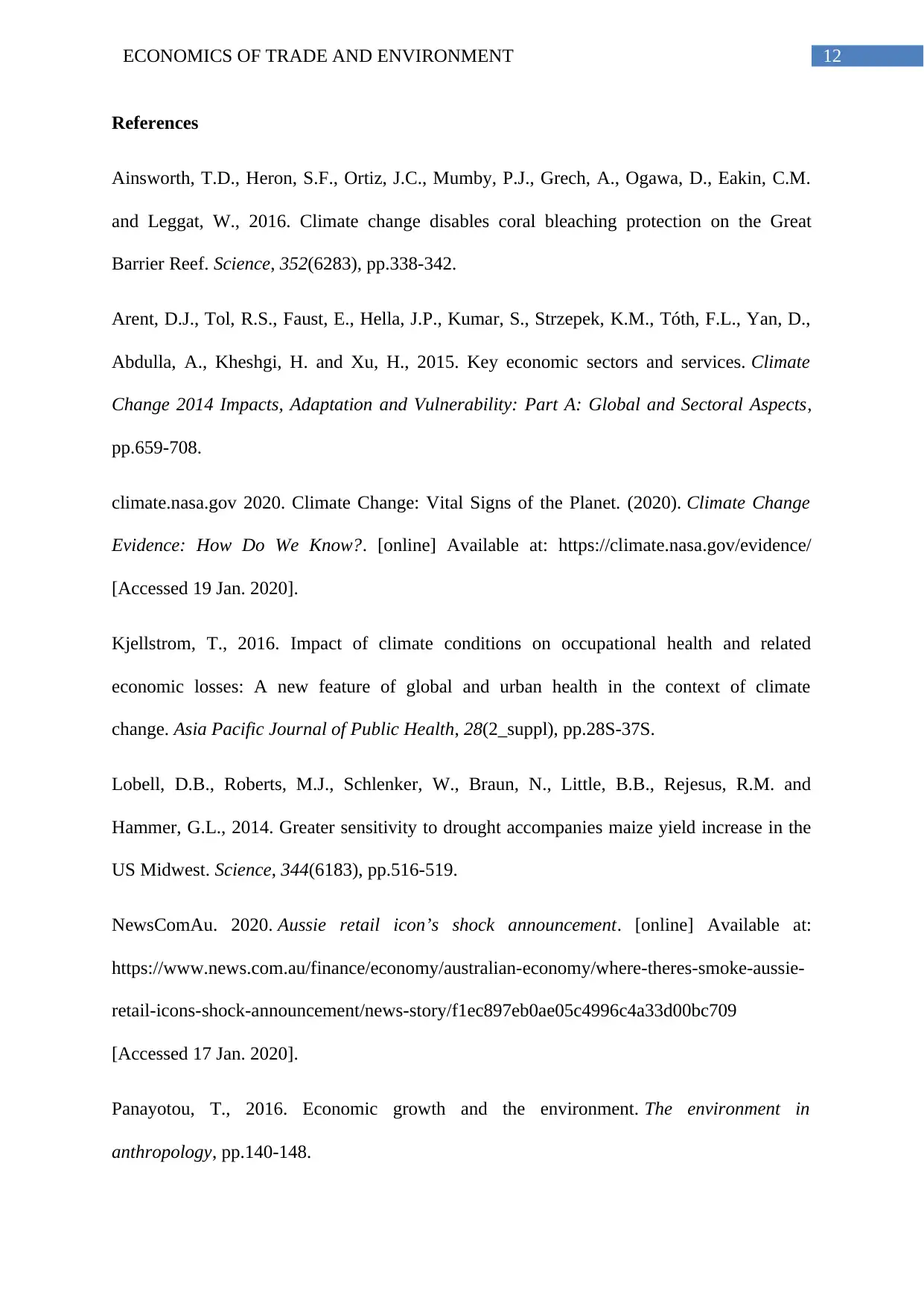
12ECONOMICS OF TRADE AND ENVIRONMENT
References
Ainsworth, T.D., Heron, S.F., Ortiz, J.C., Mumby, P.J., Grech, A., Ogawa, D., Eakin, C.M.
and Leggat, W., 2016. Climate change disables coral bleaching protection on the Great
Barrier Reef. Science, 352(6283), pp.338-342.
Arent, D.J., Tol, R.S., Faust, E., Hella, J.P., Kumar, S., Strzepek, K.M., Tóth, F.L., Yan, D.,
Abdulla, A., Kheshgi, H. and Xu, H., 2015. Key economic sectors and services. Climate
Change 2014 Impacts, Adaptation and Vulnerability: Part A: Global and Sectoral Aspects,
pp.659-708.
climate.nasa.gov 2020. Climate Change: Vital Signs of the Planet. (2020). Climate Change
Evidence: How Do We Know?. [online] Available at: https://climate.nasa.gov/evidence/
[Accessed 19 Jan. 2020].
Kjellstrom, T., 2016. Impact of climate conditions on occupational health and related
economic losses: A new feature of global and urban health in the context of climate
change. Asia Pacific Journal of Public Health, 28(2_suppl), pp.28S-37S.
Lobell, D.B., Roberts, M.J., Schlenker, W., Braun, N., Little, B.B., Rejesus, R.M. and
Hammer, G.L., 2014. Greater sensitivity to drought accompanies maize yield increase in the
US Midwest. Science, 344(6183), pp.516-519.
NewsComAu. 2020. Aussie retail icon’s shock announcement. [online] Available at:
https://www.news.com.au/finance/economy/australian-economy/where-theres-smoke-aussie-
retail-icons-shock-announcement/news-story/f1ec897eb0ae05c4996c4a33d00bc709
[Accessed 17 Jan. 2020].
Panayotou, T., 2016. Economic growth and the environment. The environment in
anthropology, pp.140-148.
References
Ainsworth, T.D., Heron, S.F., Ortiz, J.C., Mumby, P.J., Grech, A., Ogawa, D., Eakin, C.M.
and Leggat, W., 2016. Climate change disables coral bleaching protection on the Great
Barrier Reef. Science, 352(6283), pp.338-342.
Arent, D.J., Tol, R.S., Faust, E., Hella, J.P., Kumar, S., Strzepek, K.M., Tóth, F.L., Yan, D.,
Abdulla, A., Kheshgi, H. and Xu, H., 2015. Key economic sectors and services. Climate
Change 2014 Impacts, Adaptation and Vulnerability: Part A: Global and Sectoral Aspects,
pp.659-708.
climate.nasa.gov 2020. Climate Change: Vital Signs of the Planet. (2020). Climate Change
Evidence: How Do We Know?. [online] Available at: https://climate.nasa.gov/evidence/
[Accessed 19 Jan. 2020].
Kjellstrom, T., 2016. Impact of climate conditions on occupational health and related
economic losses: A new feature of global and urban health in the context of climate
change. Asia Pacific Journal of Public Health, 28(2_suppl), pp.28S-37S.
Lobell, D.B., Roberts, M.J., Schlenker, W., Braun, N., Little, B.B., Rejesus, R.M. and
Hammer, G.L., 2014. Greater sensitivity to drought accompanies maize yield increase in the
US Midwest. Science, 344(6183), pp.516-519.
NewsComAu. 2020. Aussie retail icon’s shock announcement. [online] Available at:
https://www.news.com.au/finance/economy/australian-economy/where-theres-smoke-aussie-
retail-icons-shock-announcement/news-story/f1ec897eb0ae05c4996c4a33d00bc709
[Accessed 17 Jan. 2020].
Panayotou, T., 2016. Economic growth and the environment. The environment in
anthropology, pp.140-148.
Paraphrase This Document
Need a fresh take? Get an instant paraphrase of this document with our AI Paraphraser
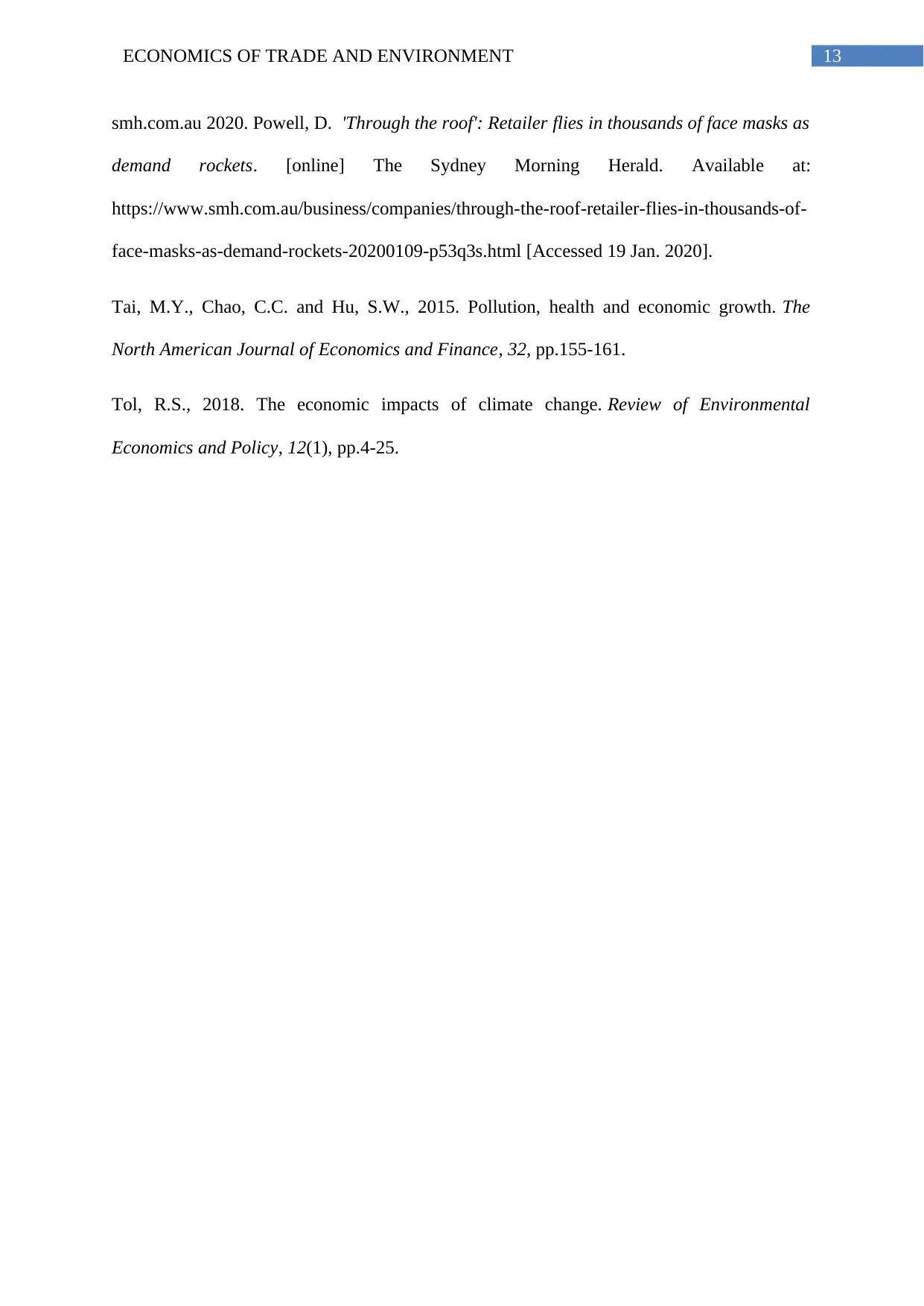
13ECONOMICS OF TRADE AND ENVIRONMENT
smh.com.au 2020. Powell, D. 'Through the roof': Retailer flies in thousands of face masks as
demand rockets. [online] The Sydney Morning Herald. Available at:
https://www.smh.com.au/business/companies/through-the-roof-retailer-flies-in-thousands-of-
face-masks-as-demand-rockets-20200109-p53q3s.html [Accessed 19 Jan. 2020].
Tai, M.Y., Chao, C.C. and Hu, S.W., 2015. Pollution, health and economic growth. The
North American Journal of Economics and Finance, 32, pp.155-161.
Tol, R.S., 2018. The economic impacts of climate change. Review of Environmental
Economics and Policy, 12(1), pp.4-25.
smh.com.au 2020. Powell, D. 'Through the roof': Retailer flies in thousands of face masks as
demand rockets. [online] The Sydney Morning Herald. Available at:
https://www.smh.com.au/business/companies/through-the-roof-retailer-flies-in-thousands-of-
face-masks-as-demand-rockets-20200109-p53q3s.html [Accessed 19 Jan. 2020].
Tai, M.Y., Chao, C.C. and Hu, S.W., 2015. Pollution, health and economic growth. The
North American Journal of Economics and Finance, 32, pp.155-161.
Tol, R.S., 2018. The economic impacts of climate change. Review of Environmental
Economics and Policy, 12(1), pp.4-25.
1 out of 14
Related Documents
Your All-in-One AI-Powered Toolkit for Academic Success.
+13062052269
info@desklib.com
Available 24*7 on WhatsApp / Email
![[object Object]](/_next/static/media/star-bottom.7253800d.svg)
Unlock your academic potential
© 2024 | Zucol Services PVT LTD | All rights reserved.




